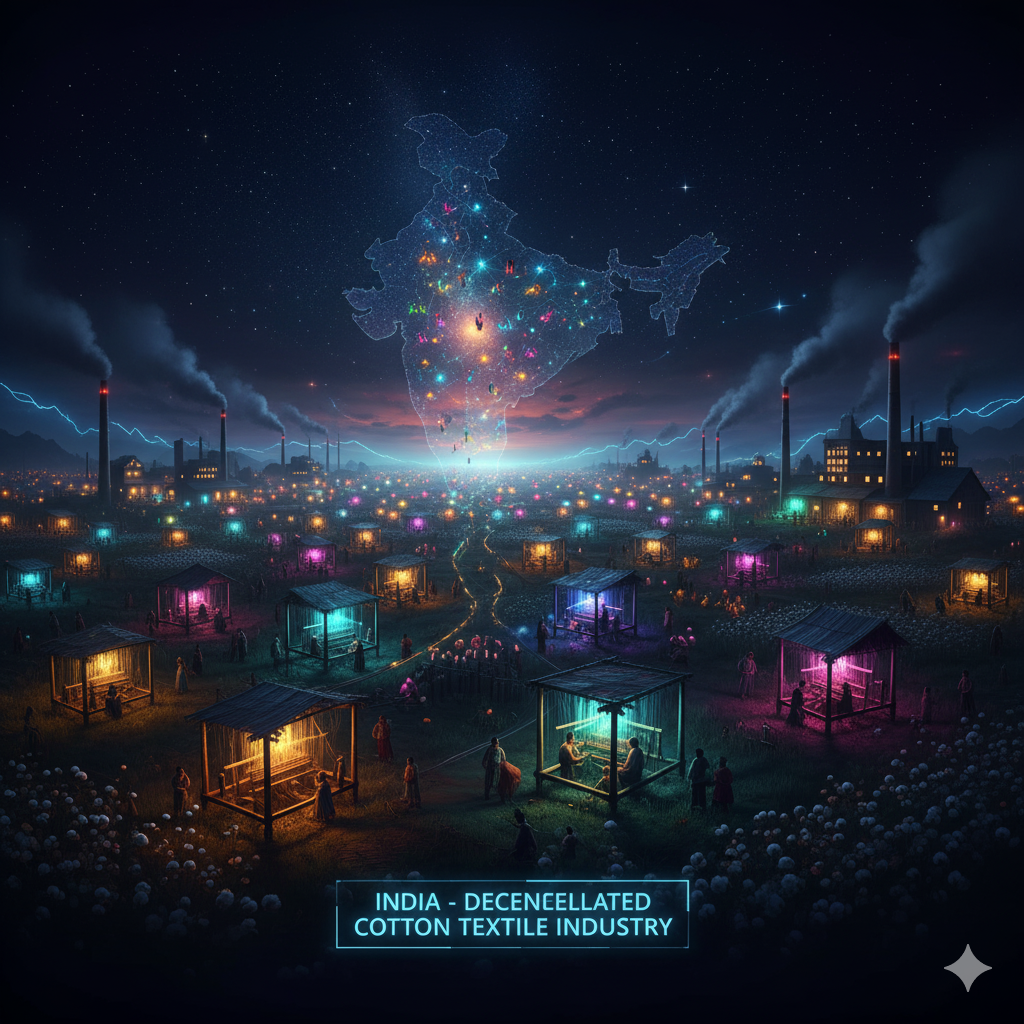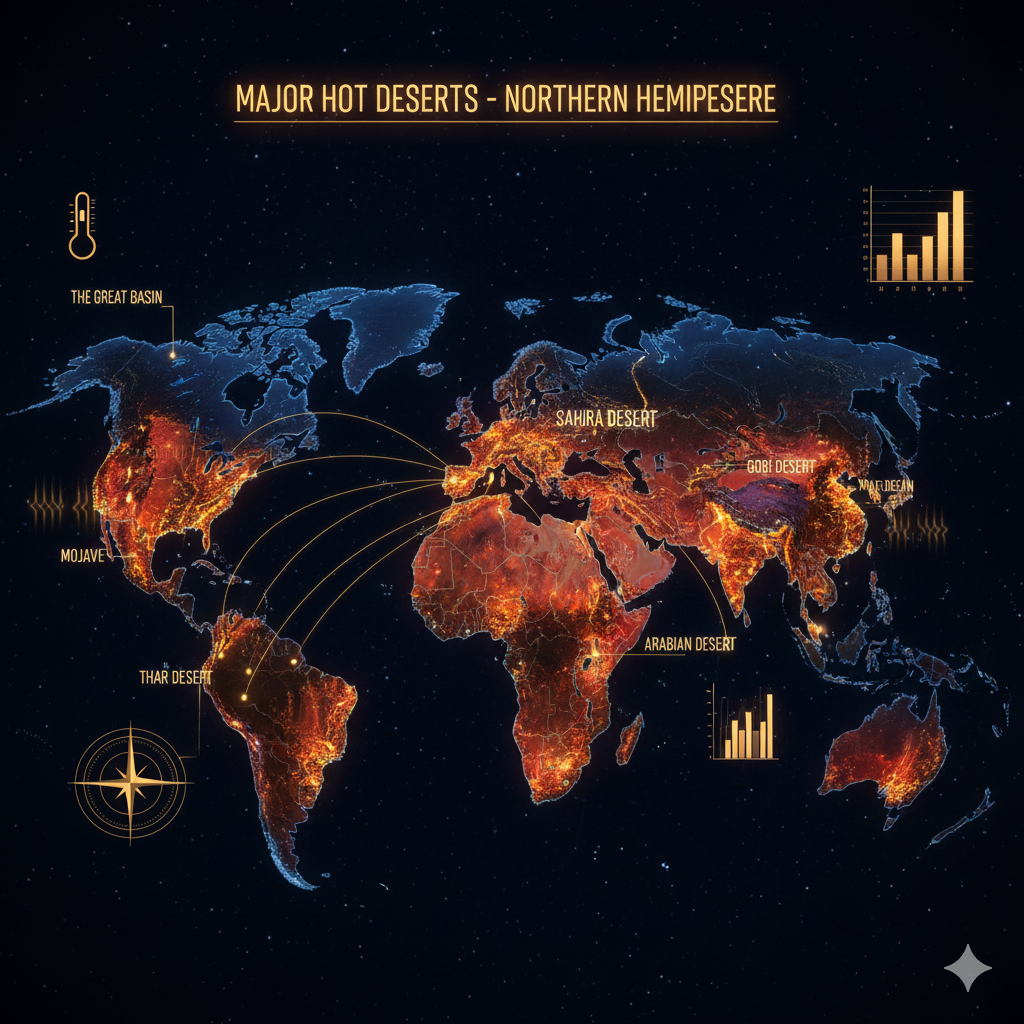Introduction
The cotton textile industry is one of the oldest and most significant sectors of India’s economy, tracing its roots back to ancient times. Known for its craftsmanship, handloom weaving, and regional diversity, this industry has evolved into both a large-scale mechanized sector and a highly decentralized cottage and small-scale industry.
Unlike many modern industrial sectors concentrated in urban centers, India’s cotton textile industry is spread across numerous regions, from traditional handloom villages to semi-urban centers with small spinning and weaving units. This decentralized pattern is shaped by a complex interplay of historical, geographical, economic, social, and technological factors.
This essay critically examines the reasons for the highly decentralized nature of the cotton textile industry in India, highlighting its historical evolution, regional specializations, raw material availability, labor dynamics, and policy factors. It also discusses the advantages and challenges of this decentralized structure, making it suitable for educational and UPSC-level studies.
1. Historical Evolution of Cotton Textile Industry in India
1.1 Ancient and Medieval Roots
- India has a long history of cotton cultivation and textile production, dating back over 5,000 years.
- Ancient civilizations like the Indus Valley Civilization produced fine cotton fabrics, which were traded extensively with Mesopotamia and Egypt.
- During the medieval period, India became renowned for handloom weaving, particularly in regions like Gujarat, Bengal, Maharashtra, and Tamil Nadu.
Significance:
- Handloom weaving was traditionally home-based, carried out in villages and small towns.
- Local specialization in fabrics, dyeing, and weaving techniques emerged, forming the foundation of today’s decentralized industry.
1.2 Colonial Impact
- During British rule, large-scale mechanized mills were established in cities like Mumbai, Ahmedabad, Kanpur, and Coimbatore.
- However, the cottage and handloom sector remained intact, especially in rural areas where mills could not penetrate.
- British colonial policies promoted export-oriented mill production while discouraging certain local handloom sectors, but regional textile traditions survived.
2. Geographical Factors
2.1 Proximity to Raw Material
- Cotton cultivation is widespread across Maharashtra, Gujarat, Andhra Pradesh, Telangana, Madhya Pradesh, Punjab, and Tamil Nadu.
- Villages near cotton-growing areas developed small spinning, weaving, and ginning units, reducing transport costs.
- Example: Ahmednagar, Solapur, and Coimbatore districts evolved as decentralized textile hubs due to easy access to raw cotton.
2.2 Availability of Water and Energy
- Many decentralized textile units are located near rivers and water sources for washing and dyeing processes.
- Low-scale energy requirements are met locally through biomass, grid electricity, or small hydro setups, making village-based units viable.
2.3 Regional Specializations
- Different regions developed unique fabrics based on local climate, soil, and cultural preferences:
- Bengal: Muslin and fine cotton textiles.
- Gujarat: Bandhani, khadi, and cotton handloom products.
- Maharashtra: Solapur towels and dhotis.
- Tamil Nadu: Coimbatore power looms and handloom sarees.
- These specializations encouraged local entrepreneurship, supporting a decentralized network of production.
3. Socio-Economic Factors
3.1 Labor Abundance and Skill Availability
- The cotton textile industry is labor-intensive, especially in handloom weaving, spinning, and embroidery.
- Rural areas provide cheap, skilled, and semi-skilled labor, often from family-based or community groups.
- Skills are hereditary, passed from one generation to another, sustaining decentralized production units.
3.2 Cottage and Small-Scale Industry Tradition
- Many weaving and spinning activities are home-based, allowing flexibility in work and income.
- Small units often require minimal investment, enabling even small farmers or artisans to participate.
- Examples include khadi weaving in villages of Uttar Pradesh, Madhya Pradesh, and Chhattisgarh.
3.3 Regional Clusters and Social Networks
- Production units cluster around artisan communities sharing skills, technology, and markets.
- Examples:
- Bhagalpur (Bihar) for Tussar silk-cotton blends.
- Surat (Gujarat) for embroidery and small-scale weaving.
- Social networks reduce transaction costs, provide labor stability, and facilitate decentralized production.
4. Technological Factors
4.1 Low Capital Requirement
- Decentralized units rely on simple looms, hand-spinning wheels, and small ginning machines.
- Unlike mechanized mills, these units do not require expensive infrastructure or high energy consumption, making rural adoption feasible.
4.2 Flexibility and Adaptability
- Decentralized units can adapt quickly to market demands, producing customized, niche products.
- Example: Artisans can produce handwoven sarees, embroidered fabrics, or ethnic cotton wear for local or export markets.
4.3 Integration with Large Mills
- Many decentralized units supply partially processed cotton or specialized fabrics to large-scale mills in cities like Mumbai, Ahmedabad, and Coimbatore.
- This networked system enables large mills to focus on mass production while small units maintain regional and traditional fabric lines.
5. Market and Economic Considerations
5.1 Domestic and Export Demand
- Domestic market: Rising demand for handloom, khadi, and ethnic wear sustains village and semi-urban textile units.
- Export market: Traditional fabrics and handloom products attract international buyers, especially from Europe, USA, and Japan.
- The decentralized industry can respond to niche demands better than large-scale mills, which focus on volume.
5.2 Employment Generation and Rural Income
- Decentralized production generates rural employment, reducing migration to urban areas.
- It promotes income distribution across villages rather than concentrating profits in cities.
- Examples: Villages in Maharashtra and Gujarat where entire communities are engaged in cotton weaving and embroidery.
5.3 Government Policies and Support
- The Handloom Development Board, Ministry of Textiles, and Khadi and Village Industries Commission provide:
- Subsidies for looms and machinery.
- Skill development programs.
- Marketing and export assistance.
- Policies encourage small-scale and rural-based textile entrepreneurship, maintaining decentralization.
6. Advantages of Decentralized Cotton Textile Industry
- Employment creation in rural and semi-urban areas.
- Preservation of traditional skills and crafts.
- Flexibility to adapt to market demands.
- Low capital and energy requirements.
- Contribution to rural economy and reduction of urban migration.
- Support for export-oriented niche products, increasing foreign exchange earnings.
7. Challenges of Decentralized Cotton Textile Industry
7.1 Technological Obsolescence
- Small units may lag in modernization, affecting efficiency and competitiveness.
7.2 Quality Control and Standardization
- Variability in production techniques leads to uneven quality, making global marketing challenging.
7.3 Market Access
- Small producers often lack direct access to large markets, relying on intermediaries, which reduces profit margins.
7.4 Financial Constraints
- Limited capital prevents investment in advanced looms, dyeing units, and marketing infrastructure.
7.5 Competition from Large Mills and Imported Fabrics
- Mechanized mills produce high-volume, low-cost fabrics, while imports from countries like China and Bangladesh pose competition to decentralized units.
8. Regional Examples of Decentralized Cotton Textile Industry
- Maharashtra: Solapur towels and cotton dhotis produced in decentralized village units.
- Gujarat: Bhuj, Surendranagar, and Jamnagar handloom units produce Bandhani and embroidered cotton.
- Tamil Nadu: Coimbatore and Salem districts host numerous small-scale cotton spinning and weaving units.
- Bihar and Uttar Pradesh: Bhagalpur silk-cotton handloom clusters.
- Andhra Pradesh and Telangana: Small towns producing cotton fabrics for domestic and export markets.
9. Policy Implications and Recommendations
- Modernization Support: Subsidies for modern looms, dyeing, and processing units to enhance efficiency.
- Skill Development: Training programs for younger generations to sustain traditional weaving skills.
- Market Access: Direct marketing platforms, e-commerce, and export facilitation for small-scale units.
- Financial Assistance: Low-interest loans and credit support to rural textile entrepreneurs.
- Sustainability: Promotion of eco-friendly dyes and water-efficient processing to mitigate environmental impact.
10. Conclusion
The highly decentralized cotton textile industry in India is a product of historical evolution, regional specialization, labor availability, agro-climatic suitability, and socio-economic networks. Its unique decentralized nature allows India to maintain a diverse textile ecosystem, combining large-scale mechanized mills with small-scale handloom and cottage industries.
Advantages: Employment generation, preservation of traditional crafts, market flexibility, and contribution to rural income.
Challenges: Technological lag, quality control, market access, and competition from large mills and imports.
Future prospects: With supportive government policies, technological upgrades, and better market integration, India’s decentralized cotton textile sector can continue to thrive, sustaining traditional skills while contributing significantly to economic growth, rural development, and global textile trade.
The decentralized structure remains both a strength and a challenge, requiring balanced strategies that protect artisan livelihoods, encourage modernization, and enhance global competitiveness.




